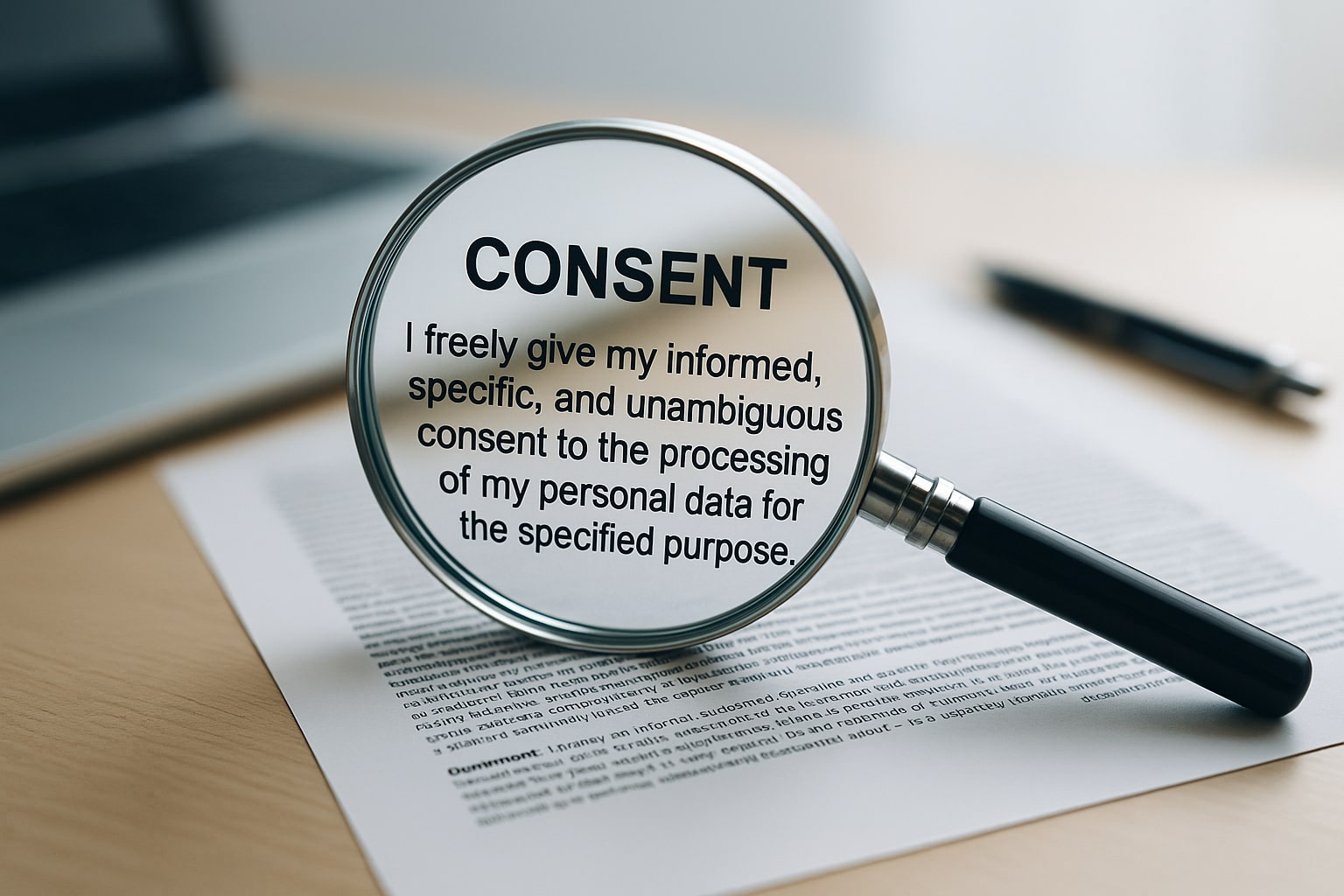
Consent stands as the cornerstone of lawful data processing under India’s Digital Personal Data Protection Act, 2023 (DPDPA). While the concept of consent is familiar from global laws like GDPR, the DPDPA introduces specific nuances, particularly around its strict definition, the mandatory pre-consent notice, language accessibility, and the novel concept of Consent Managers. For businesses, simply getting a user to click an “I Agree” button is no longer sufficient; consent under DPDPA must meet a significantly higher bar to be considered valid.
This article decodes the essential elements of DPDPA-compliant consent, providing businesses with a practical understanding of what they need to implement.
The Gold Standard: What is Valid Consent under DPDPA?
The DPDPA sets demanding criteria for what constitutes valid consent. It must be:
Free
Given without coercion, undue influence, or any form of pressure. The Data Principal must have a genuine choice.
Specific
Clearly linked to one or more defined, explicitly stated purposes for processing. Blanket or vague consents (“for improving our services”) are no longer acceptable. Each processing purpose requires specific consent.
Informed
The Data Principal must understand what they are consenting to. This is primarily achieved through the mandatory pre-consent notice (detailed below). They need to know what data is being collected, why, and how it will be used.
Unconditional
Consent for processing personal data cannot be made a pre-condition for accessing a service unless that specific processing is necessary for providing that service. Bundling consent for non-essential processing with essential service access is prohibited.
Unambiguous with a Clear Affirmative Action
Consent must be given through a distinct, positive action by the Data Principal. This means actions like ticking an unchecked box specifically for that consent or clicking a dedicated ‘accept’ button for a particular purpose. Pre-ticked boxes or implied consent (e.g., “by using our services, you consent…”) are invalid.
The Crucial Pre-Consent Notice
Before, or at the time of, requesting consent, Data Fiduciaries must provide the Data Principal with a clear and comprehensive notice. This notice is fundamental to ensuring consent is “informed.” According to the Act and further detailed in Draft DPDP Rules, this notice must clearly explain:
What personal data is being collected
An itemised description of the categories of personal data you intend to process.
The specific purpose(s) for processing
A clear explanation of why each category of personal data is needed and how it will be used, including an itemised description of the goods, services, or uses enabled by such processing.
How the user can exercise their rights
Information on how the Data Principal can exercise their rights under the DPDPA, especially the right to withdraw consent and the right to grievance redressal.
How they can complain to the Data Protection Board (DPB)
The procedure for lodging a complaint with the DPB.
Contact details for queries
Contact information for the Data Protection Officer (if applicable) or another authorised representative who can answer questions about the consent request or data processing.
The notice must be presented independently (i.e., understandable without reference to other materials) and in clear, plain language.
The Language Requirement: A Major Operational Hurdle
The DPDPA mandates that Data Principals must have the option to access the notice and the consent request in English or any of the 22 languages listed in the Eighth Schedule of the Indian Constitution. This presents a significant operational challenge for businesses, requiring substantial preparation:
Translation Capability
Businesses, especially those targeting diverse linguistic groups across India, will need access to accurate, context-aware translation capabilities for their notices and consent flows.
Platform Integration
Websites and applications must be technically capable of seamlessly offering these language choices to users.
Maintaining Accuracy
Ensuring that translations remain accurate and up-to-date as privacy notices, purposes, or services evolve is crucial and an ongoing task.
While a significant undertaking, fulfilling this requirement is vital for ensuring consent is truly “informed” across India’s diverse population.
Withdrawal of Consent: As Easy In, As Easy Out
Data Principals have the absolute right to withdraw their consent at any time. The DPDPA stipulates that the process for withdrawing consent must be as easy as the process for giving consent. This means no complicated procedures or hidden unsubscribe links.
Once consent is withdrawn, the Data Fiduciary (and any Data Processors acting on their behalf) must cease processing the personal data for the specified purpose within a reasonable time. The only exception is if continued processing is required or authorised under the DPDPA itself or any other law in force (e.g., for legal record-keeping obligations).
Necessity and Purpose Limitation
A key principle underpinning DPDPA consent is necessity and purpose limitation. The Act clarifies that consent is only valid for processing the personal data that is necessary for the specified purpose.
Collecting extra, non-essential data, even if consent is obtained alongside essential data, could invalidate that part of the consent related to the non-essential data. This reinforces data minimisation principles – collect only what you truly need for the stated purpose.
Consent Managers: A New Facilitator
The DPDPA introduces the concept of Consent Managers – entities registered with the Data Protection Board that can act as a single point of contact for Data Principals to give, manage, review, and withdraw their consents across different platforms. While the ecosystem for Consent Managers is yet to develop fully, businesses may eventually need to integrate with these registered entities to facilitate user consent management.
Actionable Steps for Businesses
To align with DPDPA’s stringent consent requirements, businesses should:
1. Review All Consent Flows
Audit every point where personal data is collected and consent is sought. Do these flows meet the DPDPA standard (free, specific, informed, unconditional, unambiguous, affirmative)? Remove any pre-ticked boxes or reliance on implied consent.
2. Revamp Privacy Notices
Ensure your privacy notices (which accompany consent requests) are clear, comprehensive, and contain all information mandated by the Act and the Draft DPDP Rules.
3. Address the Language Requirement
Start planning for multi-language notice and consent presentation. Identify your key target languages based on your user base and explore reliable translation and platform integration solutions.
4. Simplify Consent Withdrawal
Design and implement user-friendly consent withdrawal mechanisms that mirror the ease of the opt-in process.
5. Assess Data Necessity
For each processing purpose, critically review the personal data collected. Is all of it genuinely necessary for that specific purpose? Remove requests for non-essential data from your consent flows.
6. Log Everything (Audit Trails)
Maintain clear, auditable records (audit trails) of when and how consent was obtained for each Data Principal (including the version of the notice shown) and when it was withdrawn. This is crucial for demonstrating compliance.
Conclusion: Consent as a Managed Process
The DPDPA elevates consent from a simple checkbox exercise to a carefully managed, transparent, and user-centric process. Businesses must invest in redesigning their notices, consent mechanisms, and language capabilities to meet this high standard. Ignoring these detailed requirements risks not only invalidating the legal basis for processing personal data but also attracting significant penalties. Proactive and thoughtful implementation of these consent principles is key to building trust and ensuring compliance in India’s new data protection regime.
Disclaimer: The information provided in this article is for general informational purposes only and does not constitute legal advice. The content is based on the Digital Personal Data Protection Act, 2023, and the Draft DPDP Rules, which are subject to change. For advice on specific legal issues, please consult a qualified legal professional.
Need Help with DPDPA Compliance?
Contact our team of experts for personalized guidance and implementation support.



